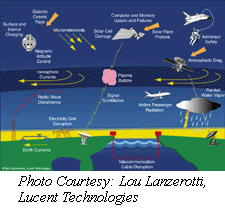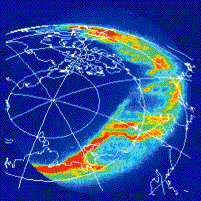Blackouts, Burnouts,
and Bummers
Aside from bright auroras, there are other less benevolent effects
of the connection between Sun and Earth. In fact, bright auroras
are merely a visible sign that the balance of electrical and
 magnetic energy in Earth’s magnetosphere has been upset. With the
average CME dumping about 1500 Gigawatts of electricity into the
atmosphere (double the power generating capacity of the entire
United States), big changes can occur in our space. Those changes
can wreak havoc on a world that has come to depend on satellites,
electrical power, and radio communication—all of which are affected
by electric and magnetic forces.
magnetic energy in Earth’s magnetosphere has been upset. With the
average CME dumping about 1500 Gigawatts of electricity into the
atmosphere (double the power generating capacity of the entire
United States), big changes can occur in our space. Those changes
can wreak havoc on a world that has come to depend on satellites,
electrical power, and radio communication—all of which are affected
by electric and magnetic forces.
For the satellites dancing in and out of the radiation belts and
the solar wind, CMEs and magnetic storms can be perilous. For
instance, a series of flares and coronal mass ejections in March
1989 produced a potent magnetic storm. After the particles and
energy from the Sun bombarded the Earth, more than 1500 satellites
slowed down or dropped several miles of altitude in their orbits
due to increased drag.
But atmospheric drag isn’t the only effect CMEs can have on
satellites. When excited and accelerated by a storm, high-energy
electrons can degrade the solar panels used to power satellites and
 can upset and even shut off computers on a spacecraft. The
increased flow of electricity in Earth’s space also can cause
electrical charge build up on the surface of a spacecraft. That
charge can eventually be released as a damaging spark (a spark not
unlike the one you get when you touch metal or a friend after you drag
your feet on a carpet). In 1994, two Canadian
satellites were
shut down when each was electrically shocked during magnetic
storms; as a result, telephone service across Canada was disrupted
for months. Similarly, in January 1997, an American satellite went
dead just hours after a CME struck the magnetosphere. The loss of
that satellite disrupted television signals, telephone calls, and
part of a U.S. earthquake monitoring network.
can upset and even shut off computers on a spacecraft. The
increased flow of electricity in Earth’s space also can cause
electrical charge build up on the surface of a spacecraft. That
charge can eventually be released as a damaging spark (a spark not
unlike the one you get when you touch metal or a friend after you drag
your feet on a carpet). In 1994, two Canadian
satellites were
shut down when each was electrically shocked during magnetic
storms; as a result, telephone service across Canada was disrupted
for months. Similarly, in January 1997, an American satellite went
dead just hours after a CME struck the magnetosphere. The loss of
that satellite disrupted television signals, telephone calls, and
part of a U.S. earthquake monitoring network.
Magnetic storms also play havoc with radio signals, which are
bounced off Earth’s ionosphere (the outermost layer of our
atmosphere, made up mostly of plasma) as a sort of natural relay
station. In March 1989, listeners in Minnesota reported that they
could not hear their local radio stations, but they could hear the
broadcasts of the California Highway Patrol. In the extreme,
magnetic storms can completely wipe out radio communication around
Earth’s North and South Poles for hours to days.
 On the ground, magnetic storms can affect the strength of Earth’s
magnetic fields. Changes in magnetic fields can produce surges in
power lines and strong electrical currents in gas and oil
pipelines. The extra current can cause pipelines to corrode and
deteriorate faster than they would naturally; in power lines, the
extra electricity can burn out transformers and cause brownouts and
blackouts. During the March 1989 storm, a transformer burned up at
a power plant in New Jersey, and a whole system was blown out at a
power station in Quebec, leaving 6 million people without
electricity for hours, some for months.
Since so much modern information is relayed by satellites and other
advanced technology—from automated teller machines and broadcast
signals to the Global Positioning System and disaster warning
systems—CMEs pose a natural and technological hazard to life on
Earth.
On the ground, magnetic storms can affect the strength of Earth’s
magnetic fields. Changes in magnetic fields can produce surges in
power lines and strong electrical currents in gas and oil
pipelines. The extra current can cause pipelines to corrode and
deteriorate faster than they would naturally; in power lines, the
extra electricity can burn out transformers and cause brownouts and
blackouts. During the March 1989 storm, a transformer burned up at
a power plant in New Jersey, and a whole system was blown out at a
power station in Quebec, leaving 6 million people without
electricity for hours, some for months.
Since so much modern information is relayed by satellites and other
advanced technology—from automated teller machines and broadcast
signals to the Global Positioning System and disaster warning
systems—CMEs pose a natural and technological hazard to life on
Earth.
NEXT PANEL: Make Your Own Sun-Earth
Connections
|